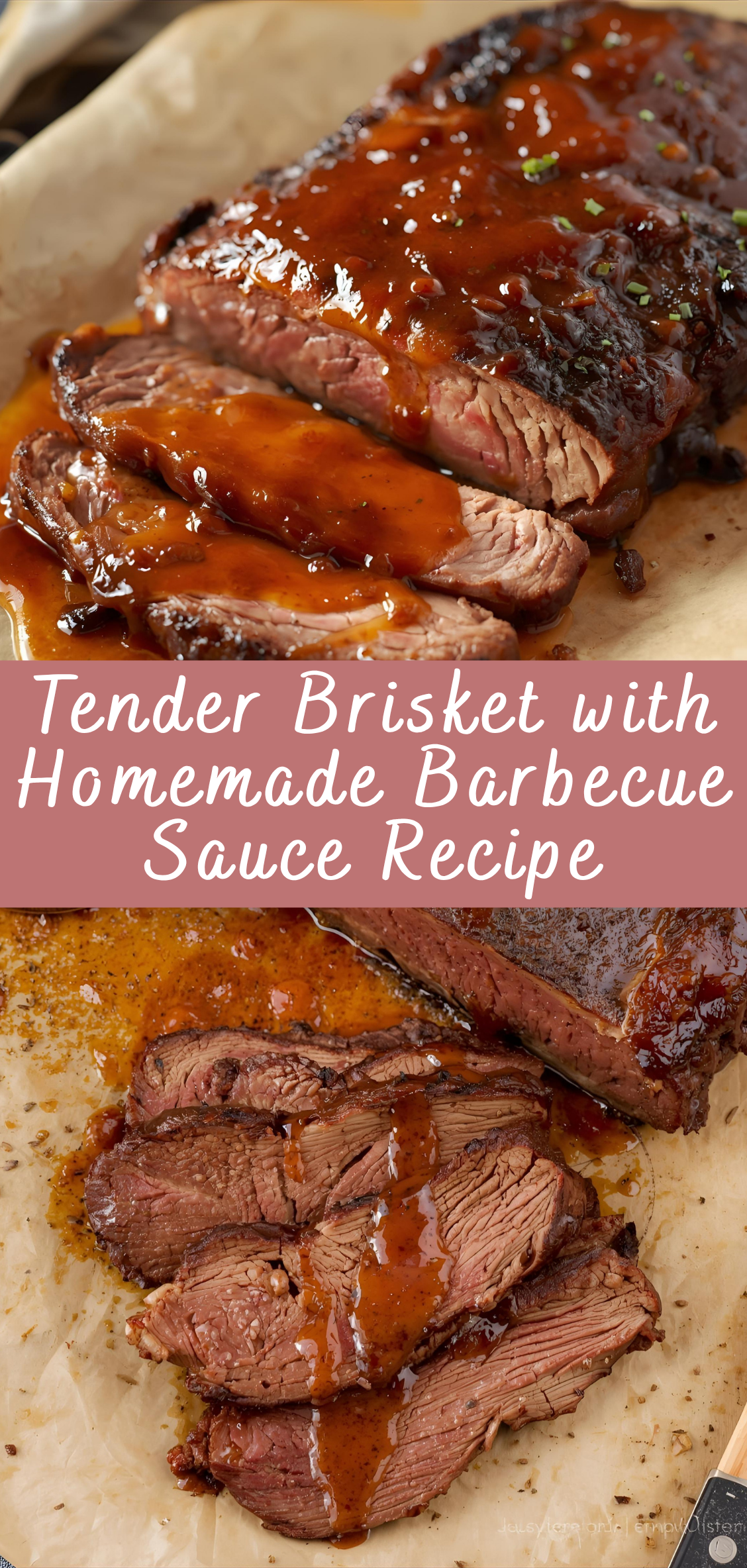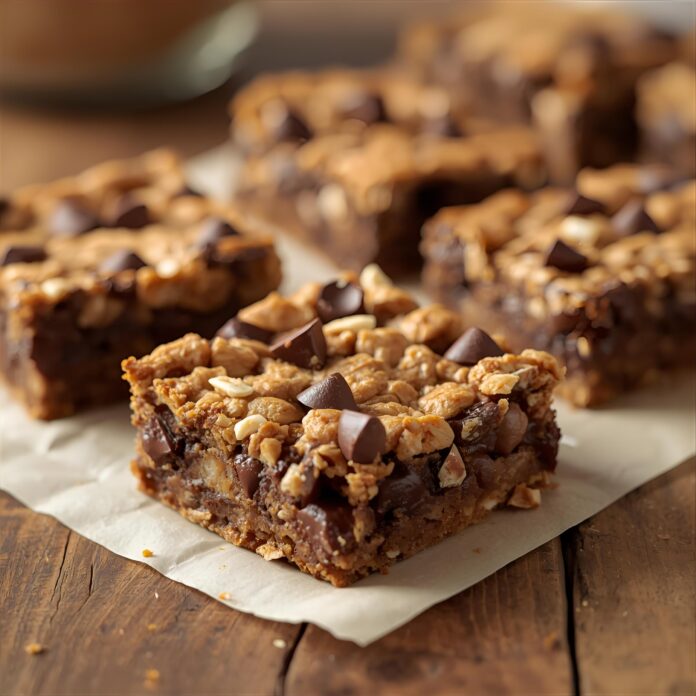Tender Brisket with Homemade Barbecue Sauce: A Slow-Cooked Masterpiece
There are few dishes in the world of slow-cooked meats that command as much respect as a perfectly prepared brisket. Known for its rich marbling, hearty texture, and the rewarding patience it demands, brisket has long been a centerpiece of Southern cuisine, barbecue culture, and home kitchens that understand the value of low and slow cooking. It’s a cut that tells a story—not just of culinary technique, but of tradition, community, and comfort.

When prepared with care, brisket becomes tender, juicy, and infused with deep, smoky flavor. But the true secret to an unforgettable brisket isn’t just in the meat—it’s in the sauce. A homemade barbecue sauce can elevate this humble cut to new heights, balancing the meat’s richness with tang, sweetness, spice, and depth. While store-bought sauces may offer convenience, a homemade version tailored to your taste allows for a personalized touch and a deeper connection to the dish.
Whether you’re a seasoned pitmaster or a weekend cooking enthusiast, this guide aims to deliver not just a recipe, but a deeper understanding of the techniques that make brisket so revered. Along the way, we’ll explore the chemistry behind tenderizing tough meat, the role of spices and acids in barbecue sauce, and how to balance time, temperature, and technique to get the best results.
So, prepare your kitchen (or your backyard smoker), gather your ingredients, and commit to the process. Because once you experience a slice of tender brisket slathered in homemade barbecue sauce, made entirely from scratch, there’s no going back.
Let’s get started.
Part 1: Choosing and Preparing the Brisket
1.1 Selecting the Right Cut
Before cooking begins, everything starts with choosing the right piece of meat. Brisket is a primal cut from the breast or lower chest of beef. It’s made up of two main muscles: the flat (or first cut) and the point (or second cut).
Understanding the Two Brisket Parts:
-
Flat cut: Leaner and more uniform in shape, ideal for slicing and presentation.
-
Point cut: Fattier and more marbled, better for shredded or pulled brisket.
For most home cooks, a whole packer brisket (which includes both point and flat) offers the best balance of flavor and texture.
Tips for Selecting Brisket:
-
Weight: Choose a brisket between 8 to 12 pounds. Anything smaller may dry out; anything larger may be hard to manage.
-
Marbling: Look for fine lines of fat running through the meat. These melt during cooking, keeping the meat moist.
-
Flexibility: Pick up the brisket at one end. If it bends easily, it’s a good sign of tenderness.
Part 2: Preparing the Dry Rub
A good dry rub enhances flavor, promotes bark (the crust that forms on the outside), and complements the natural taste of the meat.
2.1 Dry Rub Ingredients
Here’s a classic, balanced brisket rub:
-
1/4 cup kosher salt
-
1/4 cup coarse black pepper
-
2 tablespoons smoked paprika
-
1 tablespoon garlic powder
-
1 tablespoon onion powder
-
2 teaspoons mustard powder
-
1 tablespoon brown sugar (optional for a touch of sweetness)
-
1 teaspoon cayenne pepper (adjust to heat preference)
-
1 tablespoon chili powder
2.2 Mixing the Rub
-
In a medium bowl, mix all the ingredients thoroughly until evenly combined.
-
Store in an airtight container if preparing ahead. The rub keeps for several weeks.
2.3 Trimming the Brisket
Proper trimming allows for even cooking and better bark formation.
Tools Needed:
-
Sharp boning or slicing knife
-
Cutting board
-
Paper towels
Trimming Steps:
-
Pat the brisket dry with paper towels to remove excess moisture.
-
Trim the fat cap to about 1/4 inch thick. Too much fat prevents smoke and rub from penetrating the meat.
-
Remove silver skin and hard pockets of fat from the underside. These don’t render and can be chewy.
-
Square off the edges slightly for even cooking.
Don’t throw away the trimmed fat—it can be rendered into beef tallow for other uses.
Part 3: Applying the Rub and Letting it Rest
The rub needs time to adhere and begin flavoring the meat. This step is often called a “dry brine.”
3.1 Coating the Brisket
-
Lay the brisket on a sheet tray or butcher paper.
-
Apply a light coat of yellow mustard or olive oil if desired (this acts as a binder, optional but helpful).
-
Generously sprinkle the rub over all surfaces of the brisket, pressing it in gently but not rubbing it off.
3.2 Resting Time
Let the rubbed brisket rest to absorb flavor:
-
Minimum: 1 hour at room temperature
-
Ideal: Refrigerate uncovered for overnight (up to 24 hours)
Resting uncovered in the fridge also helps dry out the surface slightly, leading to better bark formation during cooking.
Part 4: Cooking the Brisket Low and Slow
There are three main methods to cook brisket: oven, smoker, or slow cooker. We’ll begin with the smoker, then outline oven and slow cooker adaptations.
4.1 Smoking the Brisket (Classic Method)
Tools and Equipment:
-
Offset smoker or pellet grill
-
Hardwood chunks or chips (oak, hickory, mesquite, or fruit woods)
-
Meat thermometer (probe style recommended)
-
Water pan (to maintain humidity)
4.1.1 Smoking Instructions:
-
Preheat the smoker to 225°F to 250°F (107°C to 121°C). Maintain steady, clean smoke.
-
Place the brisket on the grate fat side up (or fat side down, depending on heat source direction).
-
Add a water pan beneath or near the brisket to help control temperature and humidity.
-
Smoke the brisket for 6 to 8 hours, or until the internal temperature reaches 165°F (74°C).
-
This is known as the “stall” temperature, where moisture evaporates and the meat stops rising in temp.
-
-
Spritz every 90 minutes using apple juice, apple cider vinegar, or water to keep the surface moist and help bark develop.
4.2 Wrapping the Brisket (“Texas Crutch”)
At the stall, wrapping helps the meat push through the stall and stay juicy.
Wrapping Materials:
-
Butcher paper (preferred) – breathable and retains bark
-
Aluminum foil – traps more moisture, softens bark
Wrapping Instructions:
-
Lay out your butcher paper or foil.
-
Place brisket in the center and wrap tightly.
-
Return to smoker and continue cooking until internal temperature reaches 200°F to 205°F (93°C to 96°C).
-
Probe tenderness is key: A thermometer or skewer should slide in like butter in the thickest part.
-
4.3 Resting the Brisket
Resting is non-negotiable for juicy brisket.
-
Remove brisket from heat once it reaches temperature.
-
Keep it wrapped, and place it in a cooler or warm oven (170°F/77°C) for 1 to 2 hours.
-
Resting allows juices to redistribute and connective tissue to settle.
4.4 Oven-Baked Brisket (Alternative Method)
If you don’t have a smoker:
-
Preheat oven to 300°F (149°C).
-
Place brisket in a large roasting pan or on a rack with a water tray underneath.
-
Cover with foil and bake until internal temp reaches 165°F.
-
Uncover, or wrap in foil/butcher paper, and continue baking until 200–205°F.
-
Rest as above.
4.5 Slow Cooker Method (Simplified Option)
For a set-it-and-forget-it version:
-
Cut brisket to fit in the slow cooker (if needed).
-
Add 1 cup beef broth, 1/2 cup barbecue sauce (homemade or prepared), and optional onions or garlic.
-
Cook on LOW for 8–10 hours, or until fork-tender.
-
Transfer to a tray and broil briefly to form crust if desired.
Tender Brisket with Homemade Barbecue Sauce Recipe
There are few dishes in the world of slow-cooked meats that command as much respect as a perfectly prepared brisket. Known for its rich marbling, hearty texture, and the rewarding patience it demands, brisket has long been a centerpiece of Southern cuisine, barbecue culture, and home kitchens that understand the value of low and slow cooking. It’s a cut that tells a story—not just of culinary technique, but of tradition, community, and comfort.
Ingredients
- For the Brisket:
- 1 whole beef brisket (4–5 lbs), trimmed
- 2 tbsp olive oil
- Dry Rub:
- 2 tbsp brown sugar
- 1 tbsp smoked paprika
- 1 tbsp kosher salt
- 1 tbsp black pepper
- 1 tsp garlic powder
- 1 tsp onion powder
- 1 tsp chili powder
- ½ tsp cayenne pepper (optional)
- Homemade Barbecue Sauce:
- 1 cup ketchup
- ¼ cup apple cider vinegar
- ¼ cup brown sugar
- 2 tbsp molasses
- 1 tbsp Worcestershire sauce
- 1 tbsp Dijon mustard
- 1 tsp smoked paprika
- 1 tsp garlic powder
- ½ tsp black pepper
- ¼ tsp cayenne pepper (optional)
- Salt to taste
Instructions
1. Prepare the Brisket:
In a small bowl, mix all dry rub ingredients.
Pat the brisket dry with paper towels. Rub all over with olive oil, then generously apply the dry rub on all sides.
For best flavor, cover and refrigerate for 8–12 hours (optional, but recommended).
2. Make the BBQ Sauce:
Combine all barbecue sauce ingredients in a saucepan over medium heat.
Bring to a simmer, stirring occasionally.
Reduce heat and simmer for 15–20 minutes, until thickened.
Adjust seasoning to taste. Set aside or refrigerate until needed.
3. Cook the Brisket:
Oven Method:
Preheat oven to 300°F (150°C).
Place brisket in a roasting pan or Dutch oven, fat-side up. Add ½ cup beef broth or water to the pan.
Cover tightly with foil or lid. Cook for 4–5 hours, or until fork-tender.
Uncover, brush with barbecue sauce, and cook for another 30–45 minutes uncovered at 325°F to caramelize the top.
Smoker Method (Optional):
Smoke at 225°F for 8–10 hours, until internal temperature reaches 195–205°F.
Wrap in butcher paper or foil after ~5 hours, then continue until done.
Rest for 1 hour before slicing.
4. Rest and Serve:
Remove brisket from heat, tent with foil, and let rest for 30–45 minutes before slicing against the grain.
Serve with extra barbecue sauce on the side.
Notes
- Make Ahead: Brisket can be made 1–2 days ahead. Reheat gently in the oven with a splash of broth.
- BBQ Sauce Storage: Keeps in the fridge for up to 2 weeks in an airtight container.
- Fat Cap: Leave a thin layer of fat on the brisket for moisture during cooking.
- Slicing Tip: Always slice against the grain for the most tender bites.



